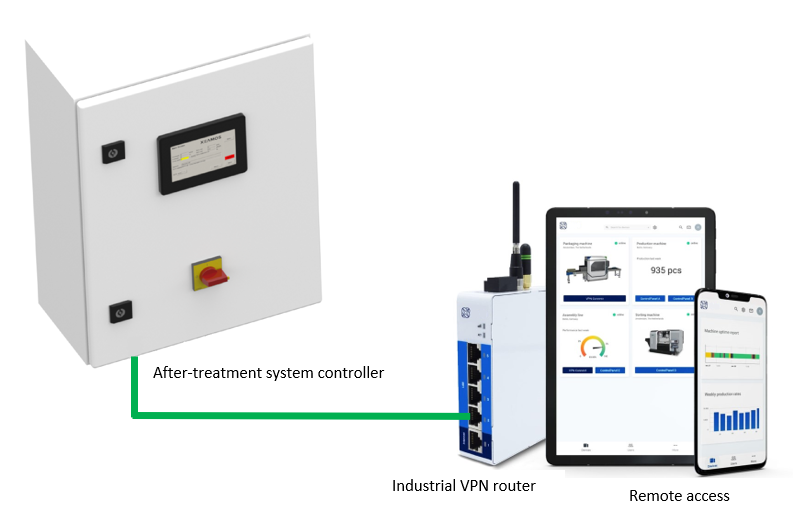

IIOT (industrial internet of things) platforms are becoming ever more sophisticated, convenient and user friendly. Indeed, the technology behind remote monitoring has come on leaps and bounds in recent years across various sectors, with the maritime sector being one of note.
Here, we discover how XEAMOS is at the forefront of improving remote access/remote monitoring for after-treatment systems, learn more about this exciting technology in development, and get hints at possible future directions.
What is remote access and what is the technology behind it?
Putting it simply, XEAMOS uses remote access/monitoring in order to monitor the performance of the after-treatment system on any vessel which has a XEAMOS exhaust gas treatment system installed.
Drilling down into the technology, XEAMOS offers a remote access industrial VPN router including an IIoT (industrial internet of things) gateway for end-to-end remote access to the after-treatment system PLC/HMI (programable logic controller/human-machine interface).
How does this work?
The VPN router is hooked up either via the wifi system on board the vessel or via a 5G cellular system which then transfers the data to the cloud.
As Freek Jansen, who has the role of Team Lead in R&D at XEAMOS, explains: “In this way, we can log into the cloud and see the condition of the system from any office in the world.
We also have an online portal accessible via a web browser, and then the portal iOS/Andriod app for mobiles, so it really is highly convenient for crew.”
He continues: “If there are any issues with the performance, the crew can give us a call, and then we can log into the system ourselves and do some fault finding to resolve any issues – so there are major benefits to it in terms of convenience!”
In short, the remote access system effectively offers the XEAMOS team of experts in the customer’s pocket. This helps customers to visualise the system in action by seeing the numbers of reduced NOx emissions for themselves, proactively offers them rapid support in case of faults or failure, as well as resolving and answering any questions they might have.

A crystal ball: The pros of predictive maintenance
Crucially for owners and crew too, remote access monitoring can also nip problems in the bud before they develop, saving both time and money along the way. As Jansen highlights. “If we monitor the system remotely, we can identify certain trends developing and make suggestions, like ‘it’s time to do maintenance,’ for example, or “soon it will be time for a software update.’
“Making conclusions based on these trends leads to predictive maintenance and avoids failures, instead of waiting until a certain component fails and then fixing it after the fact.”
As an additional benefit, staying abreast of possible weaknesses in the system also helps to avoid the much-dreaded downtime every time the system breaks down. Jansen explains further: “This represents a huge customer benefit – all they want is a system that operates smoothly, and our predictive maintenance and proactive data analysis can help achieve this, thus majorly reducing any hassle for our customers.”
What else is in the pipeline?
As with all technology worth its salt, XEAMOS is not a company to rest on its laurels, with numerous features both in development or under consideration going forwards.
Naturally, the more historical data XEAMOS is able to collect from its systems, the better the service it can provide to customers, and this will provide the source for many of its future adaptations.
Jansen explains more: “The more data you have, the more you can analyse and the better the advice you can give to customers. In the pipeline, we want to have a certain algorithm that basically tells you, “Okay, in the next 100 hours, this and this is likely to happen within the system.”
Another key development that aims to make life easier for crew would be the addition of alarm notifications from the portal, with push notifications offered on mobile devices and/or via email.
Vitally, this would mean no physical attendance of crew would be necessary in the engine control room, thus freeing them up to focus on other tasks, as well as offering real-time data from the system for the fleet manager.
The customer leads the way
It is important to note, however, that all future modifications of XEAMOS’ systems and remote access monitoring have one key priority behind them: making life easier for the customer.
Possible additions to XEAMOS’ offering include the exchange of documentation to the customer via the secure portal, which would enable the chief engineer, for example, to always have access to the most recent maintenance manuals and keep abreast of any modifications from XEAMOS.
Other potential features offered to future customers could include a service schedule outlining both the performed/planned service activities for the vessel based on live data, a chatbox on the portal for easy contact between XEAMOS’ support team and the customer and a ticket system for logging requests for system improvements, as well as flagging up system issues.
Which, if any, of these features go ahead, will depend on the shifting needs and requirements of XEAMOS’ customers. Indeed, Jansen provides us with the final word on this topic: “All of this recent technological progress in terms of remote access/remote monitoring is so valuable for us as a company. It allows us to extract data to learn for ourselves how to improve the system and keep improving it continuously.
”That said, whenever we are working on new features, we always ask: “What would be the added value for the customer if we were to implement this?” Maintaining this clear focus and drive at all times helps to keep us on track to produce the best possible systems for our clients.”